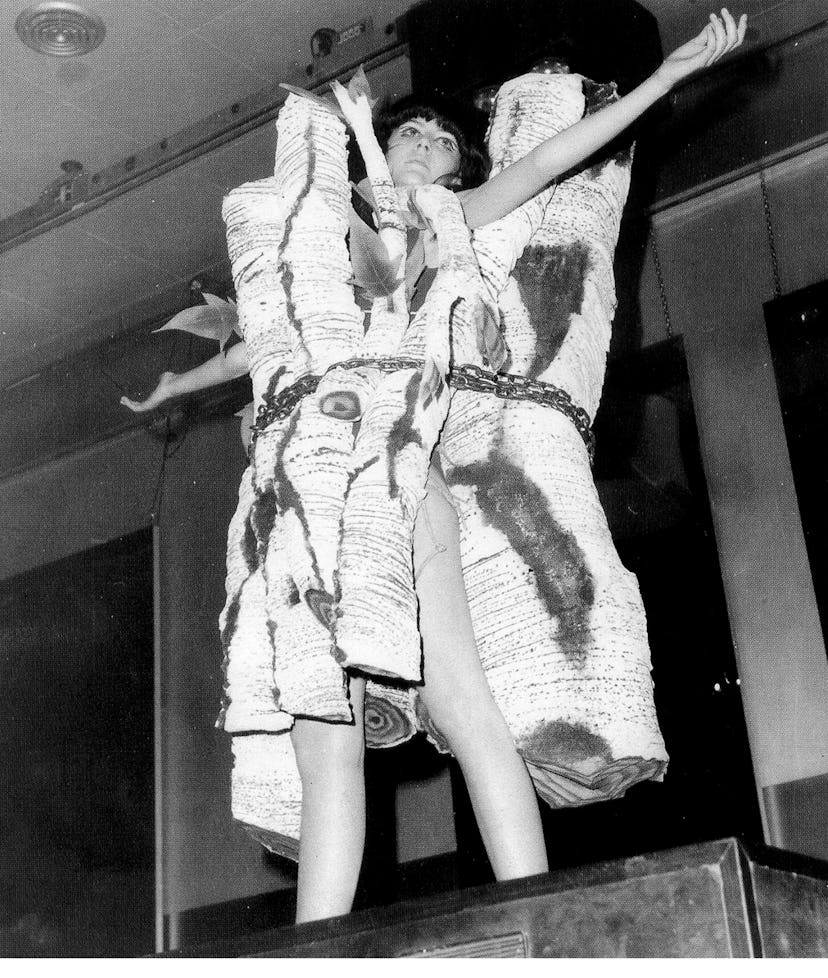Artist Piero Gilardi’s Surrealist Fashion Comes to Life Once More
The Arte Povera pioneer’s little-known, nature-inspired works alight at the Magazzino Italian Art museum in upstate New York.

At the Magazzino Italian Art museum in Cold Spring, New York—a white, modernist building that looks chic and minimal against the green pastures of Putnam County—there’s an entire room devoted to the works of the artist Piero Gilardi. A pioneer of the Arte Povera movement in the 1960s and ’70s, which saw Italian artists taking radical stances against institutions and systems of government, Gilardi’s career centered mostly on what he called Tappeto-Natura, or “nature carpets.” The “carpets” are, in fact, 3-D renderings of various nature scenes: pebbles on a beach, rollicking foamy waves with seagulls, the mossy forest ground, all done in polyurethane foam. Not only are the nature carpets laid out on the floor of the nonprofit museum, which was founded by Nancy Olnick and Giorgio Spanu in 2017 and received a significant renovation in 2020, but they’re also mounted onto the walls, like tactile paintings of sunflower fields and bushels of vegetables.
This room is among the largest of those in the sprawling museum, which spans acres and has an extensive garden, along with barns that house the museum’s resident Sardinian donkeys. And in it, there are two pieces nestled in the corner that speak to Gilardi’s fashion sensibilities: Vestito Natura Betulle, a collection of life-size birch tree trunks in that same polyurethane material worn as a dress with a chain wrapped around the mannequin’s middle and Vestito Natura Sassi, smooth stones affixed to a netted dress. At one time, the artist urged his audience to picnic on his carpets, sit on them, wear them as clothing. Now, as Magazzino director Vittorio Calabrese tells me during a recent Zoom interview from the museum’s offices in New York City, those pieces are too fragile to try on or physically interact with. However this freewheeling approach toward interacting with art was among the hallmarks of the Arte Povera artists, which included Alighiero Boetti, Gilberto Zorio, and Giovanni Anselmo.
In 1967, Gilardi unveiled the two fashion pieces, along with a third that resembled a watermelon, at a nightclub called Piper Club in his hometown of Turin, where Arte Povera flourished. These days, showing art or fashion at a club comes as no surprise, but back then, it was a revolutionary and distinctly political act to take art out of a museum. “That was very important, for Gilardi to really go to the people,” Calabrese says. Plus, the designs feel especially timely, given the Surrealist trend that’s sweeping fashion houses like Schiaparelli and Loewe—where balloon gowns and car-shaped silhouettes hit the fall 2022 runway.
Gilardi, however, did not embrace his works as fashion; they were true pieces of art. “It was literally the application of these concepts into something that you can wear,” Calabrese explains. “And it was all activated during a specific kind of performance where dancers were in the space at Piper Club, wearing the artworks while his other works were hanging around the walls of the club.”
Magazzino has plans to recreate this live presentation of the two works in October—which other museums, including Nottingham Contemporary in the UK, have done in years past. The museum is working in tandem with Gilardi, who is now 80 years old and based in Italy but was once a New York City art world fixture, appearing in multiple Andy Warhol films while living out of the Chelsea Hotel, to coordinate the performance. “Gilardi had a dream in 1966,” Calabrese says. “It was to see all his works under the same roof, almost melting into each other. And we realized that dream.” When Magazzino representatives approached the artist with the possibility of doing a performance that would bring together the carpets, the wall-mounted artworks, and the fashion pieces, he was “just completely ecstatic about it,” the director adds.
“His entire career is made on social engagement and activism. And the idea that we will be able to put these special worn pieces in relation to all those nature carpets that have never really been exhibited all together, is a dream.”